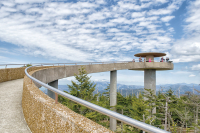A clear path
 Last Saturday, Sept. 15, was surely a gorgeous day to be ridge running high in the Plott Balsams — clear blue skies dotted with white puff-clouds; temperatures in the low to mid 60s; a great day for a hike. Not even the weight of chainsaws, brush cutters, loppers and/or swing blades could dampen the spirit or curb the enthusiasm of the dedicated crew of trail-keepers that set out from Waterrock Knob to Yellow Face and on to Blackrock.
Last Saturday, Sept. 15, was surely a gorgeous day to be ridge running high in the Plott Balsams — clear blue skies dotted with white puff-clouds; temperatures in the low to mid 60s; a great day for a hike. Not even the weight of chainsaws, brush cutters, loppers and/or swing blades could dampen the spirit or curb the enthusiasm of the dedicated crew of trail-keepers that set out from Waterrock Knob to Yellow Face and on to Blackrock.
Eleven volunteers representing The Nature Conservancy (TNC,) Western Carolina University’s (WCU) Wildlife and Forestry Club and staff and Americorps’ Project Conserve set out from Waterrock around 9:30 a.m. on their annual task of maintaining and enhancing between two and three miles of trail between Waterrock and Blackrock. According to the outing’s coordinators, Pete Bates, natural resources professor at WCU, and Megan Sutton, mountains stewardship program manager for TNC, this joint effort has been ongoing for the last five years.
There has always been a trail or “man-way” of sorts tight-roping the ridgeline from Waterrock to Blackrock. I imagine it dates back to the Cherokee, but I know locals who talk about bushwhacking their way to Yellow Face and points beyond on weekend camping trips. But, a recent series of events helped link the area between Waterrock and Blackrock. Hopefully, I have the timeline right.
The Nature Conservancy purchased the Krauss/Stansbury Tract in 1997, securing about 1,600 acres in the Plott Balsams adjacent to the Blue Ridge Parkway. Then, around 2001-2002, the Eastern Band of Cherokee Indians donated the Yellow Face Tract (about 218 acres) to the National Park Service in exchange for the Ravensford Tract where their new school is. Sylva’s old watershed was placed in a conservation easement around 2006, securing another 1,000 acres of public lands in what is now known as Pinnacle Park. The latest link in the chain is the 60-acre Blackrock Ridge, which I believe was secured in 2010 by the Southern Appalachians Highlands Conservancy.
I really enjoy the range of agencies, organizations and citizens involved in protecting these separate parcels that, when linked together, add thousands of acres of public land to an area brimming not only in scenic beauty and recreational opportunities but also in important ecological ecotones.
High-elevation northern hardwoods give way to spruce fir and balds and rock outcroppings and all are home to common and rare plants and animals. The ubiquitous black bear and common coyote traverse the region under yellow birch and witch-hobble while nervous golden-crowned kinglets and loud red-breasted nuthatches cavort in the canopy. But the area also provides a precarious toehold for endangered Carolina flying squirrels and endangered rock-gnome lichen plus uncommon species like pink-shell azalea and northern saw-whet owls.
Related Items
I also embrace the scope of volunteers — students and faculty from WCU, program managers from TNC and Americorps volunteers that value conservation and the environment enough to sweat their way to Blackrock rather than just strapping on a backpack and enjoying the hike.
These volunteers were intent on their mission, creating a clear path to Blackrock. But as I watched and mused about all the different players in this mosaic, from the different groups invested in the protection of these parcels to the eclectic group of volunteers generating the sweat, I couldn’t help but think that in these days of partisan politics and budgetary cutbacks what I was seeing was a clear path to conservation in the 21st century – the collaboration of different like-minded groups and individuals with a clear, over-arching goal of protecting the environment that sustains us.
(Don Hendershot is a writer and naturalist. He can be reached a This email address is being protected from spambots. You need JavaScript enabled to view it..)









